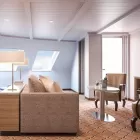- Ship
- 1 Breakfast, 1 Lunch, 1 Dinner
Ampangorinana is a village on the north coast of the beautiful and small volcanic island of Nosy Komba. The island is set between Nosy Be, the island of perfumes, and the mainland of Madagascar. Covered by a magnificent primal forest, the island is home to all kinds of trees, plants, and flowers, but lemurs are one of the main attractions. Not to be neglected and often hiding in the dense tropical forest is a multitude of other animals including maki macacos, chameleons, lizards, snakes, spiders, and 19 species of birds. Nosy Komba has easily accessible, clean, and private beaches that offer great snorkeling. Sea turtles, rays, and dolphins frequent the clear azure waters surrounding Ampangorinana and Nosy Komba.
If you have ever wanted to go somewhere that is remote and exotic, then you have come to the right place. The two right places in fact, as the islands of Nosy Be and Nosy Komba, offer a chance to revel in nature that is uncommon, even in the Indian Ocean. There is a saying in Madagascar “same, same but different” and nothing could be more illustrative when describing Nosy Be and Nosy Komba. Both feature fertile forests sheltering endemic species but while Nosy Be (meaning Big Island) attracts holidaymakers in search of a rustic, unhurried destination, Nosy Komba literally translates as Lemur Island, leaving nothing to the imagination when considering its main attractions. The aforementioned forests are without a doubt the jewel in both the islands’ crowns. The heady scent of ylang-ylang trees, vanilla, and pepper gave Madagascar its moniker of the perfumed isle, and exports of spices and scents continue to be a pivotal part of the island’s economy. The island is essentially French-speaking, after the queen of the Boina Sakalava tribe called upon the French from the nearby Reunion (thus inviting colonial rule) in 1841. If making the 20-minute boat trip to Nosy Komba (actual name Nosy Ambariovato) and the lemur park, then be prepared to be enchanted. The arboreal primates, with their enormous eyes, soft fur, and long curling tails are both charismatic and friendly. Add cheeky to the list too, especially if you have any fruit in your hands. They’ll jump right out of the trees and take it from you.








/140x140.webp)
/140x140.webp)
/140x140.webp)
/140x140.webp)
/140x140.webp)
/140x140.webp)
/140x140.webp)










